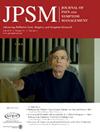临床医生的观点强调了肌萎缩性侧索硬化症患者早期双重应对技能的必要性。
IF 3.2
2区 医学
Q2 CLINICAL NEUROLOGY
引用次数: 0
摘要
背景:ALS的诊断可能是具有挑战性的,许多人找到了适应的方法。与此同时,即使提供了高质量的多学科护理,也可能在ALS诊断后早期出现情绪困扰。当情绪困扰发生时,随着时间的推移,它会变成慢性的,并且会影响ALS患者和他们的护理伙伴(统称为二人组)。目的:我们开始了解ALS多学科临床医生对ALS患者及其护理伙伴所经历的挑战的看法,这些患者在诊断后经历情绪困扰,以及应对技能项目帮助这些患者及其护理伙伴的潜在益处,弹性共同-ALS (RT-ALS)。方法:我们对MGH的Sean M. Healey & AMG渐缩性脊髓侧索硬化症中心的17名临床医生进行了半结构化的焦点小组和个人访谈(N=2个焦点小组和5个访谈),以获得以下四个方面的反馈:1)临床中看到的渐缩性脊髓侧索硬化症双性患者的社会心理需求;2) RT-ALS临床流程及转诊系统;3)临床合作模式支持RT-ALS;4) RT-ALS节目内容及手册格式。我们进行了快速数据分析的时间效率混合归纳-演绎主题方法。结果:临床医生指出,双重痛苦(痛苦经历的病人和他们的护理伙伴单独和作为一个单位),虽然不是普遍的,往往出现在诊断后早期。对建议的项目内容(二元和个人应对技能)和结构(诊断后约2个月内提供6周虚拟会议)的反应是积极的。多学科临床医生强调了一个以技能为基础的项目对经历早期情绪困扰的夫妇的重要性,因为转诊可以很容易地整合到临床流程中,以免增加提供者和夫妇的负担。结论:RT-ALS治疗方案的内容和结构是临床医生可以接受的。接下来,必须从双方寻求进一步的意见,以确定这种类型的计划是否值得关注,如果是,则进行试点并完善该计划,以进行可行性测试,然后进行有效性测试。本文章由计算机程序翻译,如有差异,请以英文原文为准。
Clinician Perspectives Highlight the Need for Early Dyadic Coping Skills for People Living With Amyotrophic Lateral Sclerosis
Context
A diagnosis of ALS can be challenging, and many people find ways to adapt. At the same time, emotional distress can arise early after an ALS diagnosis even when high quality multidisciplinary care is provided. When emotional distress occurs, it can become chronic over time, and can affect both the person living with ALS and their care-partner (together called a dyad).
Objectives
We set out to understand ALS multidisciplinary clinicians’ perception of the challenges experienced by people with ALS and care-partners who experience emotional distress after diagnosis and potential benefits of a coping skills program to help these patients and their care-partners, Resilient Together-ALS (RT-ALS).
Methods
We conducted semi-structured focus groups and individual interviews with 17 clinicians at the Sean M. Healey & AMG Center for ALS at MGH (N = 2 focus groups and five interviews) to elicit feedback on four domains: 1) Psychosocial Needs of ALS Dyads seen in the clinic; 2) Clinic Flow and Referral System to RT-ALS; 3) Clinic Partnership Approach in Support of RT-ALS; 4) RT-ALS Program Content and Manual Format. We conducted rapid data analyses for a time-efficient hybrid inductive-deductive thematic approach.
Results
Clinicians noted that dyadic distress (distress experienced by both patient and their care-partner individually and as a unit), though not universal, is often present early after diagnosis. The response to the proposed program content (dyadic and individual coping skills) and structure (6 weekly virtual sessions delivered within about 2 months after diagnosis) was positive. Multidisciplinary clinicians emphasized the importance of a skills-based program for dyads experiencing elevated early emotional distress for which referral can be easily integrated within clinic flow so as not to not increase provider and dyad burden.
Conclusion
RT-ALS program content and structure is acceptable to clinicians. It is imperative to next seek further input from dyads about whether this type of program would be of interest and if yes, to pilot and refine the program for feasibility testing and then efficacy.
求助全文
通过发布文献求助,成功后即可免费获取论文全文。
去求助
来源期刊
CiteScore
8.90
自引率
6.40%
发文量
821
审稿时长
26 days
期刊介绍:
The Journal of Pain and Symptom Management is an internationally respected, peer-reviewed journal and serves an interdisciplinary audience of professionals by providing a forum for the publication of the latest clinical research and best practices related to the relief of illness burden among patients afflicted with serious or life-threatening illness.

 求助内容:
求助内容: 应助结果提醒方式:
应助结果提醒方式:


